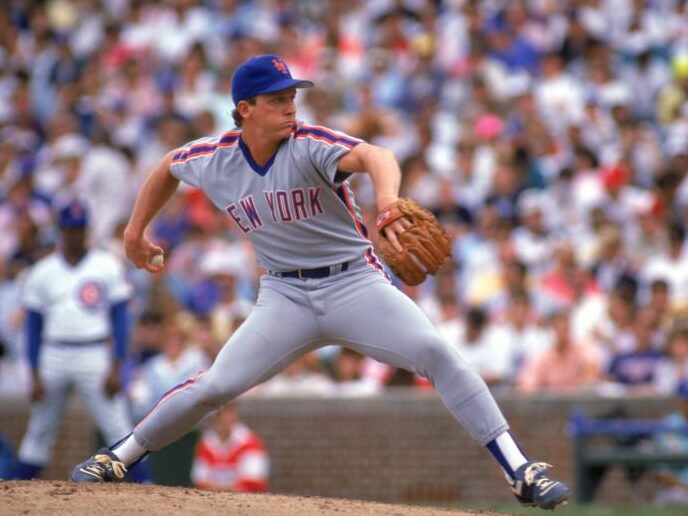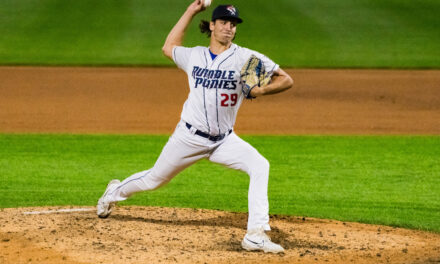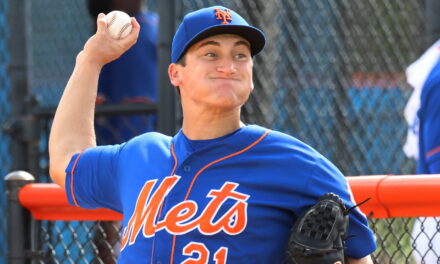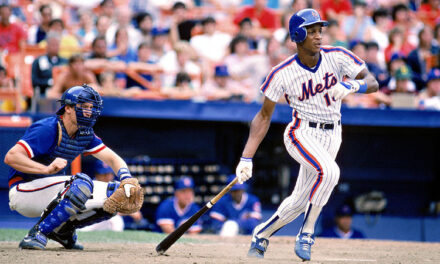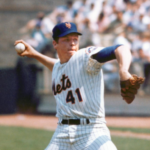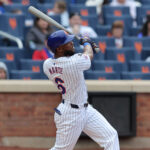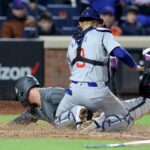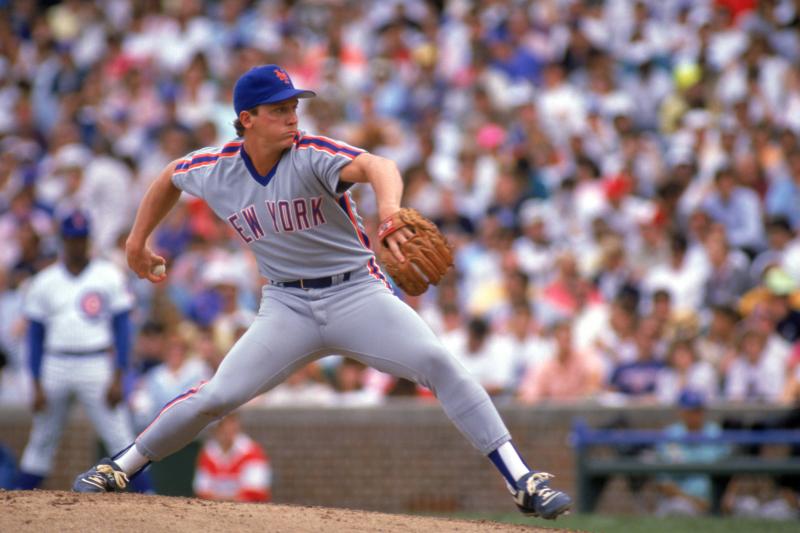
For seventeen major league seasons, David Cone continually sought information and tutelage for anything that would help give him an advantage on the mound.
From seeking instruction as a 19-year-old prospect from future Hall of Fame pitcher Gaylord Perry, to pitch designing before it became en vogue in today’s game, to assimilating with the advanced metrics for his benefit on the mound and financially, Cone is and has been a true student of the game.
Cone, 56, took what he learned – along with his already talented right arm which featured a mid-90s fastball, a slider with tremendous break and splitter with great drop – and turned that into a career in which he won 194 games with a career ERA of 3.46.
His other accomplishments include being a five-time All-Star, Cy Young Award winner, five-time World Series champion, pitching the 16th perfect game in major league history and compiling a career bWAR of 62.3.
His numbers warrant serious consideration for the Hall of Fame, yet, in the first year he was eligible in 2009, Cone did not muster the required five percent to stay on the ballot for future consideration. In baseball history, there have been 65 pitchers who recorded a career bWAR of 60.0 or better. Forty-seven of the 65 are enshrined in Cooperstown, four are still active, one is not yet eligible and 13 (including Cone) are on the outside looking in.
Even without enshrinement, there’s no denying the legacy Cone made on the field with his gifted right arm that helped three different organizations reach the postseason a total of eight times. But the athletic abilities were just part of what made Cone so special.
A pitcher’s mindset is extremely complex. Knowing which of his pitches are working that given day, understanding the opposing hitter’s vulnerabilities at the plate, utilizing scouting reports and being in-sync with your catcher all while trying to remain calm under intense pressure are just some of the difficulties pitchers face each time they step foot on the mound. For Cone, the fervent competitor that he was, embracing the challenges and using his baseball intellect were key components of his makeup.
On the mound, Cone appeared to be a master chess player, seemingly always a step or two ahead of the opposition and using his high baseball IQ to toy with lineups at will. To be given a front-row seat to understanding that type of baseball psyche would be invaluable.
Teaming with YES Network analyst Jack Curry, Cone authored such a book titled Full Count: The Education of a Pitcher (Grand Central Publishing, May 14), which brings readers inside the mind of a pitching savant. The book features a blend of anecdotes, strategies and behind the scenes tales that encapsulates what made Cone one of the most thoughtful and competitive pitchers to ever toe the rubber.

Grand Central Publishing
The memoir offers a glimpse into Cone’s childhood, where his father Ed instilled a strong work ethic and dedication to practice early on, to beginning his major league career with his hometown Royals, to the New York years. Cone doesn’t shy away from any controversy in his pages, explaining and at times owning mistakes he made in his past that made him a stronger and smarter player and person.
The pairing of Curry and Cone is a seamless one, in which Curry captures the voice of his colleague and friend so well. Those who read the book will come away with a much deeper and educational appreciation for the art of pitching, with Cone as the perspicacious professor.
I had the privilege of speaking to both Cone and Curry about their book in mid-May.
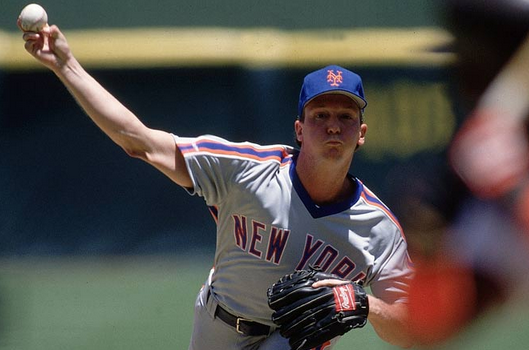
MMO: How did the idea for writing this book come about?
Cone: The idea came from Jack Curry, who I’ve known for so long going back about twenty years when he was a New York Times columnist. We’re both kind of pitching nerds; we both enjoy conversations that kind of peel back the layers of pitching and we’ve had a strong connection now that we work together with the YES Network.
It was kind of his idea and it was an easy sell for me because I have such a good bond and trust with him that we both clicked. I’m really glad that he’s the guy who approached me and it was really a lot of fun working with him.
MMO: You detail your baseball career in this book, including the various transactions. What were your initial reactions to getting dealt to the New York Mets in March 1987?
Cone: I had never been to New York and being a kid from Kansas City that was an intimidating situation. Not only just going to New York, but this was the following year after the ’86 Mets. They were a legendary team with a clubhouse that was really intimidating.
When I first walked through the Mets’ clubhouse in spring training it was [Darryl] Strawberry, [Gary] Carter, [Dwight] Gooden, Keith Hernandez and the whole crew from that legendary Mets team that I almost didn’t speak for a week! Those guys were just the top of the heap to me. Not only a great team but their personalities were so bold that it was very difficult for a rookie to walk into that clubhouse.
MMO: We’ve seen players that are simply unable to handle the New York spotlight and pressures. You not only handled it but thrived in both New York organizations. What would you credit your ability to handle all that comes with playing in the Big Apple to?
Cone: I really give a lot of credit to that group that I just described. Those Mets really embraced me and embraced my style. I had an all-over-the-map dial in terms of how I pitched. I would throw sidearm, I would drop down for sliders. And that style, I think, was one of the reasons that the Royals traded me. There were a lot of pitching coaches in the Royals organization that tried to change me and told me that I couldn’t do this: “You can’t drop down sidearm, you’re not Luis Tiant!”
When I went to go pitch for the Mets they loved my style! One of the first games that I pitched for the Mets I threw a sidearm slider to Jack Clark from the Cardinals and I struck him out. Keith Hernandez and Wally Backman threw the ball around the infield and they were almost laughing. They came up to me and embraced me after that game. It was the first time I really felt like I could be me. They liked my style and it was liberating for me.
I give a lot of credit to those guys. Ron Darling took me under his wing and showed me around the Big Apple. Rusty Staub was still associated with the Mets back then and he showed me how to love New York City and I just fell in love with it. I fell in love playing for the Mets, I fell in love with New York City and I really never left.
MMO: In the book, you dedicate a lot of space to your parents (and rightfully so!), but especially your father. How influential was he in developing your passion and educational-side of the game?
Cone: He was huge! He was my first and best pitching coach. My dad was a fanatic, a baseball fanatic and he loved the game. He was a blue-collar worker, he worked the graveyard shift at a meatpacking plant and that was a big part of my childhood; understanding that he worked nights and that when he got home he’d take a quick nap and then be ready for practice.
That kind of dedication just really stayed with me and the further removed I get from it the more I appreciate the sacrifice that he made back then. Not only just the sacrifices but the coaching that he gave me. He really did teach me how to back off a little bit, how to develop finesse, how to throw strikes first before you go maximum effort. A lot of his lessons really stayed with me my entire career.
MMO: You detail the work you put in with the former bullpen and pitching coach for the Kansas City Royals Bruce Kison. Can you talk about the plan he introduced to you called X-Games and what it did for your approach with hitters?
Cone: I really clicked with Bruce Kison, who just recently passed away over the last few years. When we connected with the Royals, after my Mets days, he just seemed to make sense to me. He saw the stuff that I had, he embraced it and he took it to the next level.
He helped me design pitches and this was in a day before pitch design. You hear a lot about that nowadays with the analytics in how to create and design a pitch. How’s the tunneling effect on your pitches? Are they all coming out on the same plane and then move at the last minute to different directions? He was really ahead of the curve on that pitch design theory and it really paid off.
He showed me how to use all of my pitches on both sides of the plate and how to sequence these pitches and set up hitters. And what it culminated with was a Cy Young Award in 1994 with the Royals, and a lot of it had to do with my comfort level with him and the things we really clicked on and the things we designed together and implemented. It gave me a second life in my career and carried me throughout the end of my career.
MMO: Something I didn’t know about you until reading the book was that you didn’t play high school baseball and instead played in a league with older competition called the Ban Johnson League.
Cone: Yeah, it’s really true. The high school I attended did not field a baseball team and so I had to play during the summer. The best league in Kansas City in the area was called the Ban Johnson League. It was really a college league and it was 21 and under, so anyone up to 21-years-old could play in that. There were a lot of college players from the Midwest from the University of Kansas, Missouri, even Nebraska would come in.
I was 15-years-old at the time playing in that league and pitching in that league and just barely holding my own. I really got challenged by a lot of older players. But I think in the long run that really helped me. It hurt me with my draft status; I didn’t have a lot of exposure and not a lot of scouts knew about me. But the fact that I was so young playing against older college competition I think really made me tougher and made me realize how difficult it is.
It was really challenging and I think it did help me in the long run and to this day I still sponsor a team in that league. That’s kind of a payback for what that league did for me.
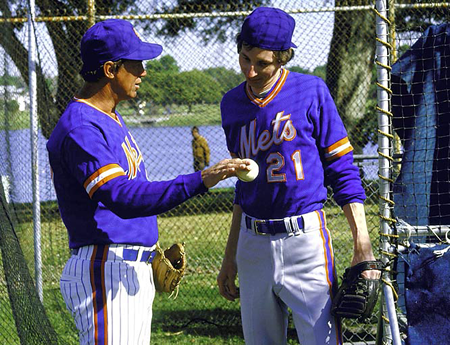
MMO: You devote an entire chapter in your book to tipping pitches, which I found fascinating. What was your own experience like with tipping pitches, which you found out about from Tommy Herr after the Mets acquired him in August 1990?
Cone: It’s always been an art for hitters – especially veteran hitters – to be able to look for cues or hitches from pitchers so that they know what’s coming. That’s a big advantage for hitters. If you can know what’s coming then you can anticipate the pitch and do some damage when it does come into the strike zone.
A lot of the time you don’t even realize it. We had some video work back in the eighties with the Mets, but not a lot. It was really kind of that you were at the mercy of hitters or pitching coaches to help you through it. Certainly, Mel Stottlemyre helped me a lot, too. He changed my style but Tommy Herr was the one that told me exactly what I was doing, and I didn’t even realize it!
Usually, it’s in the glove that you have to change grips and a lot of times hitters look at your glove and if you’re doing something different with your glove, maybe you’re opening it up a little bit wider on a split-finger or curveball, that could be a tip that you need to disguise.
Tommy showed me how I dropped my glove down low, I would immediately get my glove lower when I threw offspeed pitches, mainly sliders, curves and splitters. And with my fastball I didn’t have that dip in my glove, my hands would go directly over my head. That subtle tip happened early enough in the delivery to give the hitters enough time to decipher what was coming.
It really was Tommy Herr, the former Cardinal who became a Met, that kind of clued me in on what I was doing.
MMO: What was it like as a young pitcher having your own cheering section as you did with the Coneheads at Shea? Is it true that Andrew Levy – who’s your business agent and friend – started it?
Cone: Yes, that is correct. Andrew and I are still together, he helps me run my foundation and he’s still my business partner. But it all started back then before I first met him, that started the Coneheads at Shea Stadium. And to me, that was just the most exciting thing I had ever seen!
For a young kid from Kansas City to start having a cheering section at Shea Stadium just lit me up. I couldn’t believe that people would show up on the day I would pitch and put on those Coneheads. And obviously, it was a popular skit on Saturday Night Live back then and then eventually a movie, it was something that motivated me.
It was a fun time to be a member of the Mets.
MMO: You write very candidly about your displeasure with the trade that sent you from the Mets to the Toronto Blue Jays in August 1992. You write that “then and now, I believe the Mets were careless to trade a gutsy player like me.” Can you talk about that trade a bit?
Cone: I certainly understand from the Mets perspective now with the proper hindsight that I was going to be a free agent and they had a tough decision to make. We had not reached an agreement on an extension at that point but the trade really blindsided me because it happened after the trade deadline. The deadline is at the end of July and that came and went in 1992, so I thought I was going to be safe. I thought I was going to stay with the Mets and maybe rekindle some extension talks on the contract side.
I cleared waivers and that year there was maybe a little bit of collusion going on with the owners that allowed players or entire rosters to get through waivers after the trade deadline to keep the trades open. That’s why I was so shocked at the time about the trade. I did not expect it and was blindsided by it. I really loved playing for the Mets, I was really disappointed.
I felt like I was rejected; I loved New York. I loved pitching at Shea and even though I got traded to the Blue Jays and we ended up winning the World Series that year, once again it was a great experience to pitch big games in a World Series and be part of a championship team, but when the trade went down I was devastated.
MMO: You wrote that your 1993 season was what later inspired your interest in sabermetrics, as you had a losing record but recorded the highest single-season WAR of your career (7.2). Can you talk about your fascination with sabermetrics, and how you would’ve utilized them during your playing career?
Cone: I really felt, and it was portrayed that way in the media, that I had a really bad year with the Royals. I was last in the league in run support and my record was 11-14 and everybody sort of viewed that as a bomb and that I had fallen on my face. But I pitched 254 innings, was in the top-10 in ERA, and I really realized that the win/loss record is not the best way to evaluate a pitcher, to place value on a pitcher, especially starting pitchers.
I always believed that and I actually went to arbitration a couple of times against the Mets in the early nineties and beat them based on that theory that win/loss record wasn’t the best way to evaluate a pitcher, that there are other numbers to look at and a pitcher can only control so much.
When I was finally shown the ’93 metrics and how that gave me value where I should’ve had above and beyond the win/loss record, it just made sense to me. Even to this day I still feel like there are a lot better ways to give credit where credit is due than just the win/loss records.
MMO: I wish that more former players had your mindset when it comes to utilizing and understanding the importance of analytics. More information is better in the game.
Cone: I agree and there’s nothing to be afraid of. We’re just trying to give credit where credit is due and really place value where it should be. There are so many things that go into it for pitchers and so many things that are out of your control that don’t show up in the traditional numbers like ERA or win/loss record. The old-school stats to me were never enough.
MMO: The pitcher/catcher relationship – or the dance with catchers as you described it – is a critical part of a successful battery and performance. You write that your most memorable and seamless collaboration was with Joe Girardi on the day of your perfect game in 1999. Can you detail what made you and Girardi gel so well together?
Cone: That’s one of the chapters that Jack and I are very proud of because it shows the vulnerabilities of the pitcher, and shows the times I lose my mind out there. Catchers are the ones that have to almost be like psychiatrists at times too. Sometimes pitchers are under extreme duress out there and kind of lose their cool.
I think that’s probably one of the best parts of the book to show that I was really vulnerable and some of my behavior I’m not proud of, but I tried to explain and own it and you try to show some of the maniacal moments on the mound. Girardi was so good at that, he never took anything personally when I lost my cool on the mound. He knew how to handle me, he knew how to read my body language. He almost knew what pitch I wanted to throw just by looking at my mannerisms on the mound. His signal calling, the sequence of signs – especially with runners on base – was so quick and so on point that my rhythm and timing were never disrupted with Girardi.
We showed other catchers like Jorge Posada that it didn’t work so well with and the reasons why and even some of the times when I treated them unfairly, Jorge in particular. It was a little bit unfair of a veteran pitcher to do that to a young catcher, and that honesty and ownership in the book and the vulnerability it shows is something that I think is really kind of different. It’s an honest portrayal of moments where I didn’t handle myself so well but here are the reasons why and here’s the dynamic between pitcher and catcher.
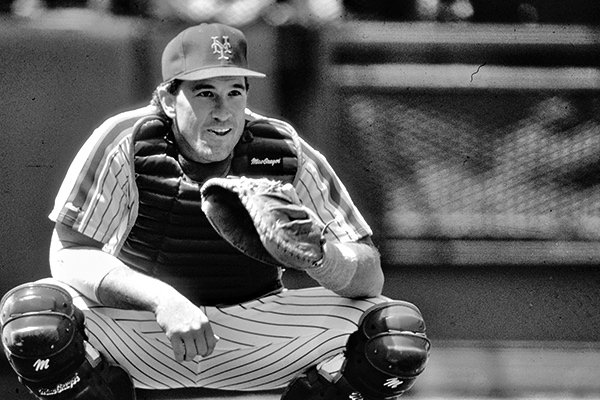
MMO: One of the catchers you write about was the late, great Gary Carter. What did having a catcher of Carter’s pedigree mean for you so early on in your major league career?
Cone: Gary was just fantastic to me. Obviously a Hall of Famer and one of the best ever at the catching position.
My first full year was with the Mets in 1988, even though I came in ’87, I had an injury and missed a lot of time that year. In ’88 that was my first full season and Gary was so good to work with. He was so nurturing and so understanding and I pretty much followed his lead for the most part. But he always made me feel like even as a young pitcher that I could shake him off. That I could still throw the pitchers that I wanted to throw and I just couldn’t have asked for a better catcher in my first full season.
The further removed I get from those Mets’ years and those first few seasons, the more I appreciate Gary Carter and the guy that was my catcher during my time.
MMO: You were – and still are – a student of the game, and during your playing career you were always viewed as smart and resilient pitcher. You go into great detail about how studied hitters and pitchers, always wanting to absorb as much information as you could. One particular interaction you had and write about is with Hall of Famer Gaylord Perry. Can you touch upon what he imparted on you and why it was so critical in your development?
Cone: Gaylord Perry is one of the all-time characters in the game and I think everybody who knows Gaylord Perry or knows the history knows that he threw a spitball and was famous for that. But he was much more than that. He was a really great pitcher and knew all the tricks of the trade and mentally he was always prepared, much smarter than anybody gave him credit for.
I just followed him around almost every day, I pestered him almost like a dog following his owner around. I think he finally got tired of me and I kept trying to get him to teach me all of those tricks of the trade. He told me I was too young and that I had a really good arm and that I didn’t need to mess around with spitballs or trick pitches at that point.
He really pushed me to work harder and to be a student of the game and that there was much more that goes into it than just learning a grip or learning the tricks of the trade. He really showed me the mentality of a big-league pitcher, of a tough pitcher and what it took to be special. For a kid that was in the minor leagues at the time that was a big influence on me because I respected him so much.
MMO: In a later chapter, you share that Bobby Valentine had reached out to you prior to the 2012 season to see if you’d be interested in being the Red Sox’ pitching coach. You write that it wasn’t the right time for you to invest in coaching. Does that thought ever creep into your mind about potentially returning to the game in a coaching/managerial role?
Cone: That itch is always kind of there. The problem for me was the full-time commitment to get back into that grind to go fully immersed once again. I think being a pitching coach or manager nowadays is more difficult than ever before, you’ve got to marry the new analytics with some of the players who may not be well-versed in it. You’ve got to be an interpreter, sort of a middle guy to help bridge the gap between old and new and that’s a job that I take very seriously.
I would never say never that I won’t do it, but I just haven’t been prepared to make that commitment as of yet. But if the right job opportunity came along I would certainly give it strong consideration because those urges are still there and you always kind of wonder what it would be like to get back into the game full-time.
Broadcasting is great, but there’s nothing like being in the dugout.
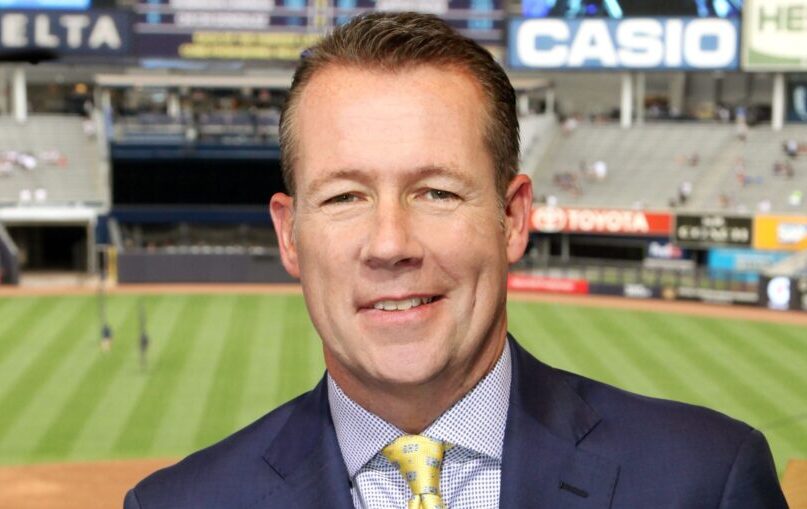
MMO: In the book’s acknowledgments you write how you approached David about collaborating on a book that dug inside the mind of a major league pitcher. How did this idea come about, and how long were you thinking of wanting to work on a project like this?
Curry: I’ve covered David since the early nineties; I’ve probably known him for more than a quarter of a century. This book goes back probably as long as that only because I’m fascinated with pitching. I’ve always thought more than any pitcher I’ve covered that when you watched David you saw the wheels spinning in his mind. You saw him thinking two, three, four, five pitches ahead, a couple of batters ahead. Should I pitch around this guy? Am I going to have my slider? Where’s my splitter?
As I got to know him as a newspaper writer I never approached him with any thought like this but I think that thought was probably always lingering back there.
When I switched careers and went from the New York Times to the YES Network and we became colleagues, that thought became a little stronger. And I guess since we work so closely at YES and we’ve had so many conversations about pitching I finally did approach him a few years ago and said, ‘Listen, this has been on my mind for a while. Would you be interested in doing this type of book?’ And like anything, when you approach someone you have your outline ready and your big pitch and he just said, “Yeah. Let’s do it!”
Fortunately, he was of like-thinking and was interested in doing that type of book, too. That’s how we set sail on doing it.
MMO: What was the overall process like of collaborating with David? How long did it take to complete?
Curry: Let’s put it this way, Mathew, I have on my MacBook forty-two different interviews transcribed that I did with David. Those were never five minutes. Not saying everyone was three hours but they probably ranged from one to three hours. We had more than forty different sessions and we’d meet at Yankee Stadium and the YES Network studios. He would come to my house, I would head into New York City and we’d do some stuff by phone.
I remember we had a deadline approaching and I was on vacation in the Caribbean and I said to my wife, ‘I’ve got to leave you on the beach for about an hour and a half, I’ve got to go do a phone interview.’
We had to get some stuff done at that point. But it was never work, to be honest with you. It never felt like somebody was doing something that they didn’t love in that being me, because every time I finished an interview with David he made me smarter about pitching and he made his book that was forming in my head better because he always had great stories. He always had great theories, always had great philosophies.
This book is close to 400 pages and there are actually things that we had to leave out that I was like, wow, I forgot that we didn’t get that anecdote or story or theory in there! That’s how much pitching wisdom and baseball stories David provided.
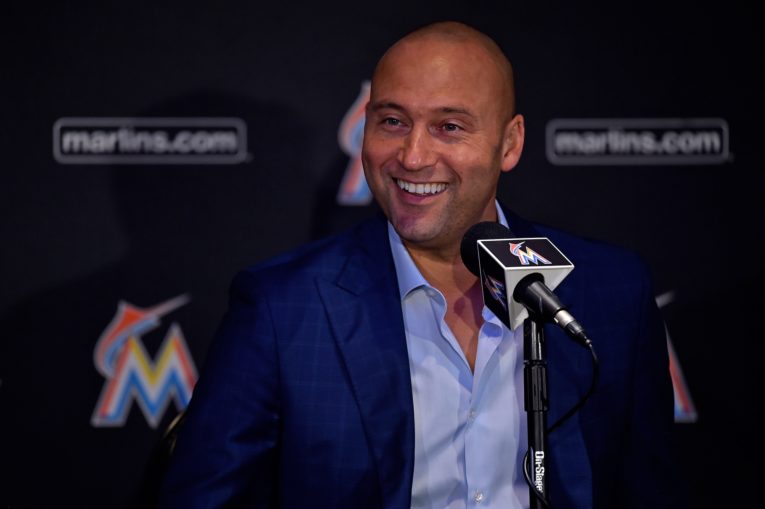
MMO: You talked about how you had to transcribe hours upon hours of interviews that you conducted with David. Did that make it easier to essentially capture his voice for the book? Is there difficulty in writing in someone else’s voice?
Curry: There was a point, and I wish I could remember exactly which chapter it was, but I had some friends in the business who helped me along the way and I acknowledged them in the back of the book. People like Ian O’Connor, Mike Vaccaro and Joel Sherman. A couple of those guys read chapters for me and there was one chapter where I think it was one of the Yankee chapters, where one of them said, “ This sounds like Cone. You really nailed this.”
When someone says that to you it’s reassuring. David along the way kept saying that. He said he was happy with it, he loved what I was doing, which was also encouraging.
It’s a process, Mathew; I can’t speak for anyone else. This is my second book, I did one with [Derek] Jeter about twenty years ago and I remember one of the greatest compliments I got after that was when Jeter’s parents said, “We felt like Derek wrote this book.”
I hope people who know Coney when they read this book say, man, this sounds like Coney because that’s what it’s supposed to sound like.
MMO: You mentioned how you’ve known David for about a quarter of a century, but I’m curious if there was one or two things that stood out to you when writing this book that you didn’t know about David?
Curry: Two things and one is going to seem so obvious but I feel it needs to be mentioned. I knew he was fascinated with pitching; I knew he was obsessed with pitching. By spending this much time with him and working on the book I’m not sure I even realized how massive that obsession was and just how much went into it when he was playing. Just how much detail he would put into it. The slightest move from a batter in the batter’s box or maybe a batter moving his front foot back an inch. If Cone thought he picked up on that, he’d try to open up his stance and maybe hit an inside pitch. This guy has a Ph.D. times ten in pitching! I knew he had a master’s, I found out he had a Ph.D. in it.
The other thing was, and it’s one of my favorite chapters in the book, called “The Dance with Catchers” and it was just the relationship with pitcher and catcher. We all know how important that relationship is and we all watch the games to see when a pitcher and catcher might be having a little bit of an issue and we can both see when they’re on the same page.
David really takes you inside that world in this book, he really lets you know that every pitcher wants a co-pilot. He’s the guy throwing the baseball but he needs somebody behind the plate who is there to reassure him, who’s going to give him a fist pump, who’s going to call the right pitch at the right time, who wasn’t going to abandon him.
David goes through catchers in his career who got him, and catchers in his career who didn’t get him. That’s a very honest and detailed chapter that I’m proud of. I’m proud of the whole book, but especially proud of that chapter because I think people can learn a lot from that chapter.
MMO: I really enjoyed that chapter as well. It was an honest assessment of what pitchers look for in a catcher and getting that curtain lifted to reveal how that dynamic works – or doesn’t – was very informative.
Curry: I was having a conversation with Austin Romine at the Stadium and I told him about this book and I specifically mentioned that chapter and he said, “I’m eager to see that.”
I think catchers who read this chapter, if they were honest would say, Cone is exactly right. He made a lot of good points here.
David talked about when you’re dying out on the mound sometimes, it may sound subtle or like a kid who gets a pat on the back before he goes out for his/her Little League game, but sometimes a fist pump or a “come on, give it to me right here,” David said those things are crucial because it’s so mental out there and you feel like you’re going down this dark hole by yourself. But if someone reaches out and gives you a hand that’s going to help you.
That’s why, as I said, catchers who read that chapter would understand that you have to be a lifeline sometimes. A psychologist, a coach, a catcher; there are a lot of things you have to be for your pitcher.
MMO: I enjoyed the anecdote about when David was throwing a bullpen and didn’t have his best stuff early on. The bullpen catcher was at least trying to frame his pitches and give him some encouragement. Girardi comes in to take over and was jabbing at them, not trying to make them look acceptable. Cone said that he was so ticked off that he threw Girardi out of his bullpen session.
Curry: That’s one of the more fun anecdotes in the book and I interviewed Girardi about that one too and he just laughed about it. And that’s why Joe and David got along so well. David had a temper, and he could intimidate catchers and he did intimidate Jorge Posada. Girardi said he never took anything David said or did on the mound personally because he knew how manic David was.
You described that scene perfectly. I think Cone threw Girardi three pitches and the way we describe it is he caught one of them like a kid waving at a helium balloon. David wanted him to fake like the slider caught the corner. And part of the reason he kicks Girardi out too, Mathew, was he didn’t want Girardi’s calling of the game to be impacted by the lousy stuff he saw in the bullpen. He wanted Girardi to believe that when he got to the mound he wouldn’t be Clark Kent and he’d be Superman all over again.
It’s a pretty interesting anecdote and essentially the only time Cone threw a catcher out of the bullpen. I’m sure it’s happened before but I interviewed twenty-five other pitchers for this book and no one had a similar story of tossing a catcher out of the bullpen.
MMO: I heard in an interview you gave with another outlet that you and Cone sat down and watched and dissected his perfect game in 1999. What was that experience like to be able to go pitch-by-pitch through a historic game like that with him?
Curry: I actually have to give my wife, Pamela, props on that one because we knew we had to do a chapter on the perfect game, but we kept putting it off. It was obvious, we’d get to it. Late in the process, I said to him, ‘We’ve got to do that chapter on your perfect game.’
I was racking my brain on how to make this different and sometimes the most obvious answer hits you in the face and that’s when my wife said, “Why don’t you sit down and watch the game and get him to go pitch-by-pitch?”
Oddly enough, and news to me, he had never done that. That replays on YES and he had seen snippets here and there, but he had never sat down and just pitch-by-pitch dissected that game, evaluated that game.
He met me at my house that day, we sat down, might’ve had a cold beverage and some popcorn. I’ve been covering baseball for over thirty years and I don’t want to say that I’m jaded; the work is the work. You go to work and that’s your job. That day was pretty cool for me I have to say. You have one of the only guys in baseball history to throw a perfect game and here he is sitting in your house going over the game.
He gave me some details that day that I don’t think he ever shared because he had twenty years to think about it. He’s in a nice setting where he gets to go back and enjoy it and that was as cool of two and a half hours as we spent in the entire time that we worked on this book.
MMO: When the Mets traded David to the Blue Jays in August 1992, David was candid in the book about his displeasure with leaving New York. From your viewpoint, how much did that trade really hurt David?
Curry: It’s interesting, there are times during interviews with David where he almost transports back to that time. That trade happened in 1992 as you said, and it still stings him. He loves New York. He was a Kansas City kid who before he got traded to the Mets had never even been to New York. He gets there and he loves everything about it: the people, the nightlife, he loved being part of those raucous, rowdy Mets. And as you said and we detail this in the book, it feels like the Mets kind of pulled the plug on a guy that not only conquered New York and dealt with all that New York had, whether it’s the media, off the field issues or going through a slump.
David felt like the Mets gave up on him.
They said he wanted a five-year deal when they had offered him a four-year, $17 million deal, which was not true. He would’ve negotiated for a four-year deal. And then when you look and he ends up going to Toronto and what he ends up doing for them and helping them win a World Series, it had a great ending. But in the moments he was traded and those first days in Toronto were rough for him. Those first couple of starts in Toronto he didn’t do too well, and I think part of it was he missed New York. He really wanted to stay with the Mets if that ever could have been worked out.
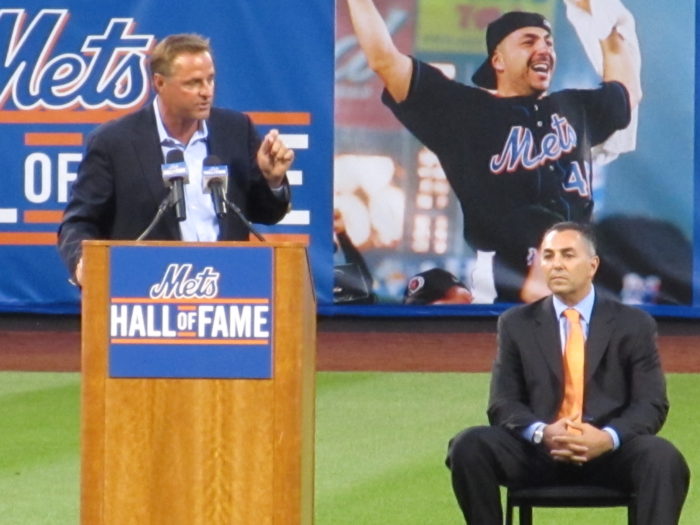
MMO: Was coming back to pitch in 2003 with the Mets almost a type of closure for Cone?
Curry: I don’t know if he looked upon that as a closure. It’s the same organization and ten years later, I don’t know if that’s related. I think that was more of he had to get the pitching out of his system, he had to see if he had anything left.
Think about this: he’s forty years old, got a bad hip and hasn’t pitched in a year. But because Al Leiter and John Franco contacted and told him this would be pretty cool and we think you could help us, he decided that he was going to crank it up one more time and give it a shot.
I think it was more about what was happening in the moment than anything related to what happened in 1992. And he kind of laments in the book that with all the talk about your arm and taking care of your arm, he’s very proud that he once went nine straight years without missing a start, that in the end, it wasn’t the arm but the hip that did him in. It was landing on that hip for all of those years, pushing off or landing. It’s really the right hip that gave him a lot of the issues.
I don’t think it was ’92, I think it was let’s give this one more try and it happened to be with the Mets.
MMO: One of the things I found really interesting about David is the fact that he was a practical joker, a guy who could let loose and just be a fun guy to be around. But he was also – and still is – such a student of the game and someone who was always looking to absorb as much information as possible to grow and get better. The Gaylord Perry story comes to mind in that regard. Can you talk about the two sides of David, and how they made him into the competitor that he was on the mound?
Curry: That Gaylord Perry story is tremendous for anyone that hasn’t read the book. Here’s David, 19-years-old and recovering from knee surgery and the Kansas City Royals had him up in the major leagues to rehab, begging Perry to teach him out to throw a spitter. I think that his desire for information and to use that information was so important to who he was as a pitcher. Now, David was talented beyond belief; he got to the major leagues throwing in the mid-90s with a nasty slider, and then he picked up the splitter, he’s an unbelievable competitor. But I think the brains and intelligence are what guided him to who he eventually became.
I think there were times in his career that he went out there with A+ stuff and just blew people away. But I think he had a 17-year career and won almost 200 games because when things start to tilt and go in the other direction and maybe your skills start to recede, it’s the wisdom, intelligence and smarts that guide you. He had a good point in the book where he says, “There’s a point in your career where you’re never going to get any better. You’ve been as talented as you’ve ever been. That’s the point where your intelligence and knowledge have to guide you.” I touched upon this a little bit in the book, I don’t think we went into it as heavily as we could have. But I would’ve loved to see what David would be like as a 2019 pitcher. I think he would be like Trevor Bauer or Adam Ottavino, you could not give him enough information.
I think he would be the kind of guy that would soak up any information that you had to make himself a better pitcher.
MMO: David states that there was a time growing up when he aspired to be a sportswriter. As an esteemed writer yourself, how do you think David would’ve fared in that profession if he chose that route instead of becoming a pitcher?
Curry: I think David would have had a long, productive, fun career as a sportswriter because he loves the sport. He loves the sport and he would’ve covered it well. He’s a competitor and I think he would’ve done very well in the market like New York. No knock on any other market, I think David would’ve thrived here because of the things I just said. Pitching wisdom, baseball wisdom and competitiveness.
We exchanged a bunch of emails along the way and he suggested things about passages and this and that and you could see that within those emails there’s a writing style there, there’s a skill there. You could hear it on the broadcasts as well, putting his sentences and thoughts together. But I think Major League Baseball is much better off that he was able to make a career out of pitching, not out of becoming a sportswriter. And as we detail in the book, his one attempt at sports writing didn’t go very well in the 1988 NLCS for Bob Klapisch as a ghostwriter for a column. David’s journalism career ended pretty quickly after that.
Follow David Cone on Twitter, @dcone36
Follow Jack Curry on Twitter, @JackCurryYES


